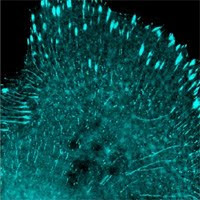Allele Biotech's Green Crystal Ball
Optogenetics
Chosen as the Method of the Year 2010 by Nature Method and mentioned in a number of year-end recaps, this is a technology that allows the use of light to precisely (at least in a temporal sense) control engineered proteins within a targeted cell population. For example, by introducing light-activated channelrhodopsins into neurons, one can use a pulse of light to initiate a movement of ion across the cell membrane. The technology, first reported in 2005 then made headlines as a major impact on neurosciences since 2007, is now being combined with other components in controlling a broader array of biological events, such as DNA binding, enzyme activities, etc. Looking forward, a few areas will be more than likely the frontlines of moving optogenetics into more labs:
Additional combinations: The few known channelrhodopsins and their fast growing variations will be combined with more “effecter” domains to control different events. The challenge will be to find ways to use the structural changes or any responses channelrhodopsins have to stimulating lights in order to trigger a reaction in the associated effecter domain.
Tracking mechanisms: A platter of fluorescent proteins (FPs) will be used as an independent tracking method to follow cells being targeted. FPs that have optical spectra that do not interfere with the optogenetic molecules will be tested and established. In addition, FPs with less toxicity, narrower excitation and emission peaks, and more tolerance to different cellular environment will be preferred and eventually set up as standards.
Delivery tools: To bring the optogenetic reagents into cells like neurons researchers will most likely rely on lentiviral vectors in most cases. Other vehicles such as baculovirus, MMLV-based retrovirus, even herpes virus may find broader applications in this field. Pre-packaged lentiviruses and MMLV-retroviruses already contain optogenetic constructs will become popular products.
VHH Antibodies
The small capture polypeptides based on single-domain Camelid antibodies (nanobodies) and similar VHH domains will become much dramatically more popular this year, judging from the significant increase in demands of the only camelid reagent products, GFP-Trap and RFP-Trap, in 2010. There are a number of NIH initiated programs that aim to find capture reagents that eventually target the complete human proteome. One of the key criteria for the current phase of the relevant NIH Director’s Initiative is ability to co-immunoprecipitate. The Human Proteome Organization (HUPO) recently expressed frustration due to the lack of high quality capture reagents necessary to isolate and identify most proteins. HUPO promotes global research on proteins in order to decode the human proteome. From what we have learned from dozens of publications showing the use of GFP-Trap, VHH molecules pulls down GFP-tagged proteins with unprecedented efficiency and purity. VHH antibodies show strong affinity and specificity, at a level superior or comparable to monoclonal antibodies. In addition, VHH antibodies are increasingly appreciated for their capabilities to recognize concave epitopes by their relatively convex-shaped paratopes. VHH nanobodies are small (~12-15 kD), with a limited number of functionally important disulfide bonds, can be expressed very well in E. coli, and are amazingly stable in extreme denaturing conditions such as heat and acid. They have been shown to be better suited for in vivo and trans-cellular membrane delivery than other antibodies. It should not be surprising that one day in the coming years VHH antibodies will be more dominant than monoclonal antibodies.
Super-Resolution Imaging
One of the goals of developing technologies such as photoactivated localization microscopy (PALM) and related super-resolution imaging (SRI) techniques was to achieve electron microscopy (EM) level resolution without using EM. Now new developments show that maybe combining EM and photoactivable FPs would provide more specific and more detailed morphology. It would be anticipated that more photoconvertible FPs will prove to work well for one type of SRI or another. The event that will bring this technology to nearly every cell biology lab is the improvement and availability of necessary instruments that some companies have already begun to commercialize.
New Product of the Week 010311-010911:
Human let-7b miRNA minigene on lentivirus with RFP reporter, ABP-RP-MILT7BLP
Promotion of the Week 010311-010911:
15% off mWasabi-based organelle markers carried on baculo2mammalian system if order this week (On-Demand products will require about 3-4 weeks for virus packaging after an order is placed). Use code 0103BACFP on fax or email order.
Thursday, January 6, 2011
New Frontiers for Research Tool Development in the New Year
Labels:
camelid antibodies,
channelrhodopsin,
EM,
halorhodopsin,
optogenetic,
PALM,
photoactivable FP,
photoconvertible FP,
STED,
STORM,
VHH
Subscribe to:
Post Comments (Atom)





No comments:
Post a Comment